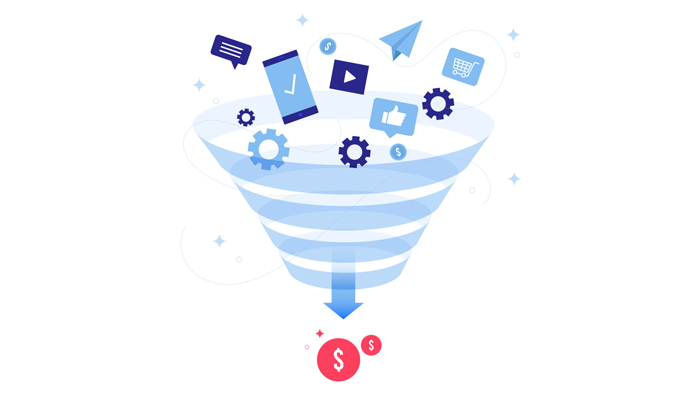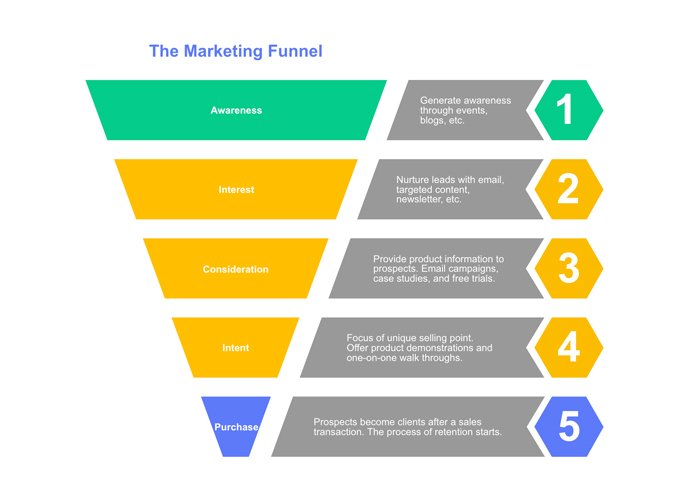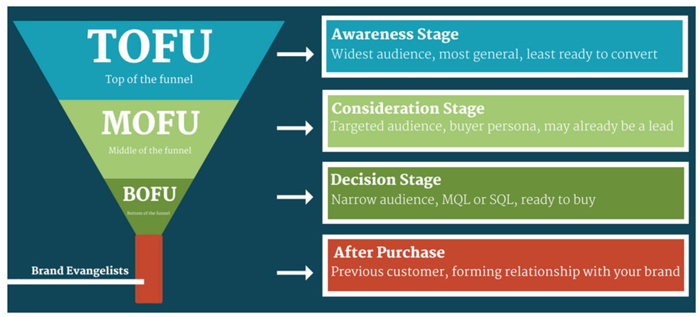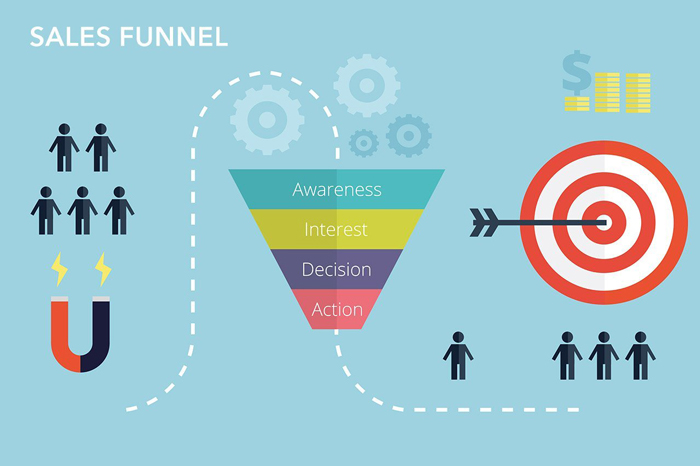Marketing funnels are an essential component of digital marketing. They help businesses attract and convert potential customers into loyal and repeat customers. In this article, we’ll explore the stages of a marketing funnel, the anatomy of a digital marketing funnel, ways to build a digital marketing funnel, how to measure the success of your funnel, and some examples of successful marketing funnels.
What is a Marketing Funnel?
A marketing funnel is a model that helps businesses visualize the customer journey, from the first interaction to the final purchase. It is a framework that outlines the various stages of the buyer’s journey, and helps businesses create targeted marketing strategies at each stage. The goal of a marketing funnel is to convert potential customers into paying customers and, eventually, loyal and repeat customers.
Why is a Marketing Funnel Important?
Digital Marketing Funnel are essential because they help businesses understand their customers’ needs, preferences, and behaviors. By mapping out the customer journey, businesses can create targeted marketing messages that resonate with their audience at each stage of the funnel. This can lead to higher conversion rates, increased customer loyalty, and a better return on investment (ROI) for marketing efforts.
How to create Digital Marketing Campaign
Stages of the Marketing Funnel
A typical marketing funnel has four main stages: Awareness, Consideration, Conversion, and Loyalty. Some marketing funnels also include an Advocacy stage, where satisfied customers become brand advocates and recommend the business to others.
Awareness (ToFU)
The awareness stage, also known as the top of the funnel (ToFU), is where potential customers become aware of a business and its products or services. At this stage, the goal is to create brand awareness and attract as many potential customers as possible. This can be done through various marketing channels, such as social media, content marketing, and paid advertising.
Consideration (MoFU)
The consideration stage, also known as the middle of the funnel (MoFU), is where potential customers start to consider a business’s products or services. At this stage, the goal is to provide valuable information that helps potential customers make an informed decision. This can be done through email marketing, retargeting ads, and personalized content.
Conversion (BoFU)
The conversion stage, also known as the bottom of the funnel (BoFU), is where potential customers make a purchase or take a desired action, such as filling out a form or subscribing to a service. At this stage, the goal is to provide a seamless and positive customer experience that encourages repeat business and referrals.
Loyalty
The loyalty stage is where businesses nurture their existing customers and turn them into loyal and repeat customers. At this stage, the goal is to provide exceptional customer service, personalized experiences, and incentives that encourage customer loyalty.
Advocacy
The advocacy stage is where satisfied customers become brand advocates and recommend the business to others. At this stage, the goal is to provide exceptional customer experiences that encourage customers to share their positive experiences with others.
The Anatomy of a Digital Marketing Funnel
A digital marketing funnel has three main stages: Top of the Funnel (ToFU), Middle of the Funnel (MoFU), and Bottom of the Funnel (BoFU).
1. Top of the Digital Marketing Funnel
The top of the funnel is where potential customers first become aware of a business and its products or services. At this stage, businesses can use various marketing channels to attract potential customers, such as social media, content marketing, and paid advertising.
2. Middle of the Digital Marketing Funnel
The middle of the funnel is where potential customers start to consider a business’s products or services. At this stage, businesses can provide valuable information that helps potential customers make an informed decision, such as email marketing, retargeting ads, and personalized content.
3. Bottom of the Digital Marketing Funnel
The bottom of the funnel is where potential customers make a purchase or take a desired action, such as filling out a form or subscribing to a service. At this stage, businesses can provide a seamless and positive customer experience that encourages repeat business and referrals.
Building a Digital Marketing Funnel (in 5 Steps)
Building a digital marketing funnel involves five main steps:
1. Create Ads & Content
Create ads and content that attract potential customers to your business. This can be done through various marketing channels, such as social media, content marketing, and paid advertising.
2. Build an Enticing Offer
Create an enticing offer that encourages potential customers to take action, such as signing up for a newsletter or downloading a free guide.
3. Set Up a Landing Page
Create a landing page that showcases your offer and encourages potential customers to take action.
4. Create Your Email Sequence
Create an email sequence that nurtures potential customers and encourages them to take action.
5. Connect the Dots
Connect the dots between your ads, landing page, email sequence, and other marketing channels to create a seamless and positive customer experience.
How Do I Know If My Marketing Funnel Is Successful?
The success of your Digital Marketing Funnel can be measured by various metrics, depending on your business goals and objectives. Here are some common metrics to track:
– Conversion rate: The percentage of potential customers who take the desired action, such as making a purchase or filling out a form.
– Cost per acquisition (CPA): The cost of acquiring a new customer.
– Customer lifetime value (CLV): The total value a customer brings to your business over their lifetime.
– Return on investment (ROI): The amount of revenue generated compared to the cost of marketing efforts.
By tracking these metrics, you can identify areas for improvement and make data-driven decisions to optimize your Digital Marketing Funnel.
Marketing Funnel Examples
Here are two examples of successful marketing funnels:
1. Melyssa Griffin
Melyssa Griffin is a successful online entrepreneur who has built a thriving business teaching others how to grow their online presence. Her Digital Marketing Funnel includes:
– Top of the Funnel: Social media ads and content marketing that attract potential customers to her website.
– Middle of the Funnel: A free email course that provides valuable information and encourages potential customers to sign up for her paid courses.
– Bottom of the Funnel: Paid courses and coaching programs that provide a seamless and positive customer experience.
2. Teela Cunningham
Teela Cunningham is a successful graphic designer who has built a thriving business selling digital products. Her Digital Marketing Funnel includes:
– Top of the Funnel: Social media ads and content marketing that attract potential customers to her website.
– Middle of the Funnel: A free design resource library that provides valuable information and encourages potential customers to sign up for her paid products.
– Bottom of the Funnel: Paid digital products, such as design templates and courses, that provide a seamless and positive customer experience.
Digital vs. Traditional Marketing Funnels
Digital marketing funnels differ from traditional marketing funnels in that they rely heavily on digital channels, such as social media, email marketing, and paid advertising. Traditional marketing funnels, on the other hand, rely on more traditional channels, such as print ads, TV commercials, and direct mail.
While both types of funnels can be effective, digital marketing funnels offer several advantages, such as the ability to target specific audiences, track metrics in real-time, and personalize marketing messages.
FAQs About Creating a Marketing Funnel
Q: How long does it take to build a marketing funnel?
A: Building a marketing funnel can take anywhere from a few weeks to several months, depending on the complexity of your business and the resources available.
Q: Do I need to hire a marketing specialist to build a funnel?
A: While hiring a marketing specialist can be helpful, it is not necessary to build a successful marketing funnel. With the right tools and resources, you can build a funnel on your own.
Q: How often should I update my marketing funnel?
A: It’s important to regularly review and update your marketing funnel to ensure it is effective and aligned with your business goals. This can be done on a monthly or quarterly basis.
In conclusion, a successful digital marketing funnel can help businesses attract and convert potential customers into loyal and repeat customers. By understanding the stages of the funnel, the anatomy of a digital marketing funnel, and how to build and measure the success of a marketing funnel, businesses can create targeted marketing strategies that drive results.



